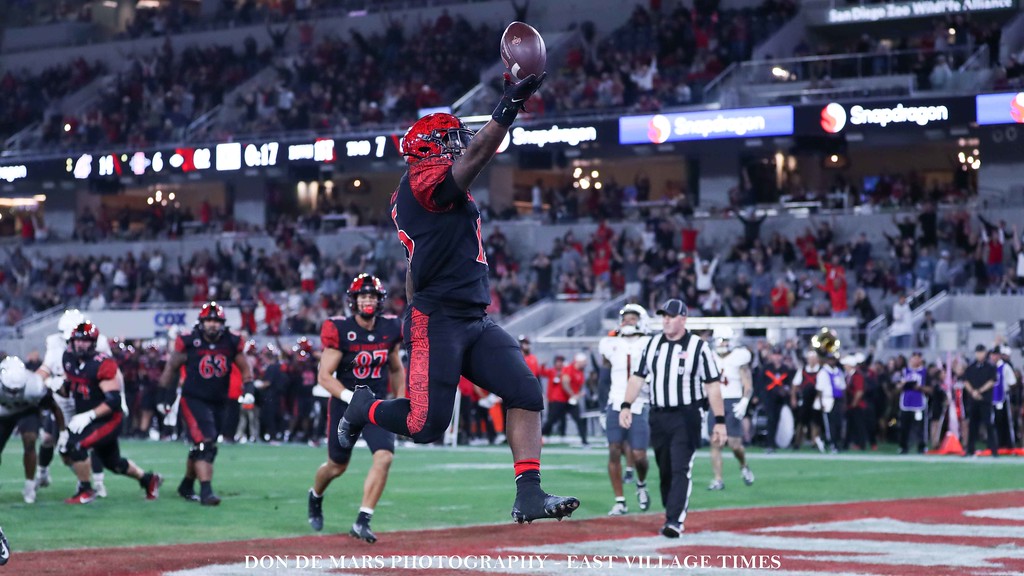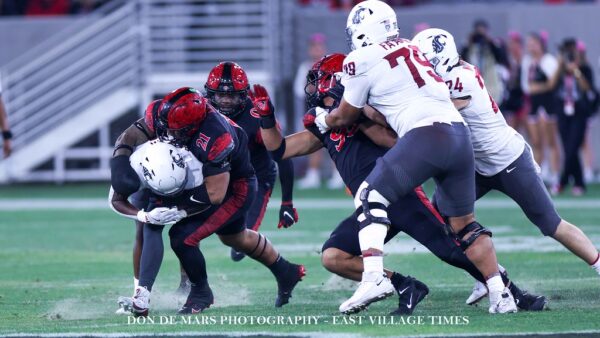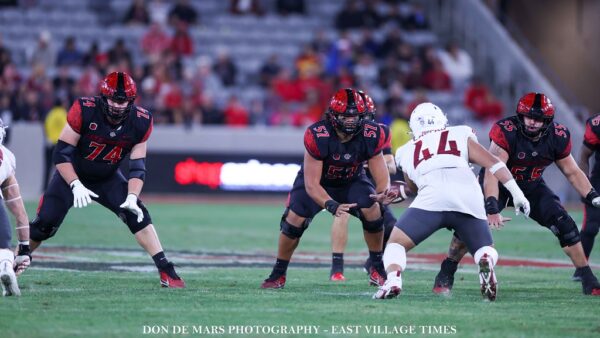SDSU vs. Boise State: Ten Things to Watch

Marquez Cooper layups up the football after crossing the goal line. (Don De Mars/EVT)

Postgame Saturday, SDSU head coach Sean Lewis expressed his affinity for wolves, calling them an obsession and his spirit animal. This week, as his pack heads to Boise to play the Broncos, he enters the territory of the Gray Wolf.
Reintroduced into the wild in Central Idaho as an endangered species, the canine is a conservation success story. Gray Wolves flourished in the area, and the population growth exceeded all expectations. Today, the state is working to reduce its numbers from a peak of about 1,600 to 500 by 2029.
They were first released into the wild in 1995 and 1996. In those same years, Boise State football transitioned from what is now the FCS level to the FBS. Their rise to prominence in college football mirrors the thriving of the Gray Wolf.
The Broncos had losing records in their first two BCS seasons but have not had one since 1997. They are currently ranked 15th in the country. Their only defeat was to no. 1 Oregon. The Ducks needed a field goal as time expired to win 37-34. BSU is expected to defeat the Aztecs by more than 24 points.
Wolves are most menacing when cornered. Their fight and resolve sharpen when they have nothing to lose. The Aztecs enter Albertsons Stadium without expectation, which Lewis hopes makes them as dangerous as a Gray Wolf.
Below are ten storylines to follow.
10. Sold Out on the Blue Turf
The homecoming crowd would have been sparse last Saturday if not for the Crimson and Gray wave that crashed into Snapdragon Stadium. The official attendance was 26,937, and about 25% were Washington State fans.
Packed together in the stadium’s southeast corner, they provided an advantage for the Cougars. When the team approached them to sing their fight song together, the chant boomed through Snapdragon.
Boise State will have no visitor interference on Friday. A week ago, the school announced that no tickets remain for BSU’s final three home games of the year. 2024 will mark the first season in school history that the university sold out every contest of its home slate.
Treasure Valley is the moniker for the Boise metro area. Its population is roughly three times smaller than San Diego County’s. Entry-level season ticket prices are about the same. Since 2015, the Broncos have won 88 games, the Aztecs’ 79. BSU is the highest-level football team in town, as is SDSU.
The memory of Boise’s heights, primarily before it entered the Mountain West, is something the Aztecs have never attained. SDSU’s most recent success occurred when the team played in Carson. BSU has a reputation for trick plays and entertaining football, even as its approach has featured the running game more than in the past.
Whatever the cause of the support gap, Lewis was hired to change it. In the world of NIL and immediate transfers, every home game is an audition not only for the home team’s players but also for athletes on the opposition’s roster. Wouldn’t it be human nature for Trey White, Danny O’Neil, Jordan Napier, Chris Johnson, or any other Aztec to pause momentarily and wonder what it would feel like running onto the blue turf in front of a sold-out home crowd?

9. First place on the line
Among the best aspects of football is each game’s importance in the scope of a season. Upsets occur regularly and have long-term repercussions. Despite the differences in the teams’ records and national rankings, SDSU and BSU enter Friday as two of three schools still undefeated in Mountain West play. Both teams control their destiny in the pursuit of a conference title.
The Aztecs and Broncos have only competed against each other nine times, but they have a budding rivalry. The Red and Black are 2-2 all-time on the Blue Turf. That mark is tied for the best visitor’s record among active FBS teams at Albertsons Stadium. Since BSU joined the Mountain West in 2012, they have 14 home losses, and the Aztecs are responsible for one-seventh.
If the contest follows the prognostications, it would be the largest spread in the series, surpassing the 17-point Boise State wins in 2011 and 2022. The Broncos have a two-game winning streak over the Aztecs. The programs have traded two-game streaks following BSU’s initial win to open the series.
Everything tangible suggests a blowout. The intangibles point to something else.
8. Freaky Friday
Friday nights are for high school football. Television executives should be ashamed for denying prep athletes the opportunity to visit a college campus. Though, it is easy to see why the time slots are coveted commodities.
Twenty-six Friday night games have been played between FBS teams this year. Fifteen have been decided by one score, 17 by fewer than 10, and six by more than twenty points. The average margin of victory when at least one Mountain West team participated in a Friday contest is 5.3 points. UNLV’s 50-34 win over Utah State three weeks ago was the only game decided by more than five points.
Preparation in sports has been reduced to replicating techniques. This makes routine central to an athlete’s experience. Playing on Friday disrupts the structures players are accustomed to during their week. This change could be the reason for the close games.
Boise State has an advantage because it played last Friday and can work closer to its normal preparation cycle. The Aztecs had to remove their typical off day on Monday to accommodate playing a day early.

7. Holding Boise under 20
Among the statistical curiosities in the SDSU and Boise State series is that the Broncos have never scored in the 20s in nine games. SDSU is 1-5 when the Broncos score at least 20 points and 3-0 when they hold BSU under 20. The only exception to this trend was in 2013 when the Aztecs won a 34-31 overtime thriller.
SDSU’s defense ranks no. 66 in the nation in scoring defense, giving up 23.6 points per game. With the offense unable to stay on the field efficiently, the defense has played an average of 73 snaps per game. Between 2018 and 2022, the Aztecs played about 65 each contest. When compared to the last seven seasons, its 0.32 points per play is comparable to 2018 (0.33), 2019 (0.33), 2021 (0.29), and 2022 (0.31), behind 2019 (0.2) and 2020 (0.27), but well ahead of last season (0.4).
Boise State is third in the country, averaging 44.3 points per game, so there is no expectation that the defense will perform to this level. But, they might have to if there is an upset. The Broncos have been held under 30 points twice this year. These occurred in their past two contests. Hawai’i and UNLV might have figured out ways to slow down BSU’s offense. Two games do not make a trend, but three would.
6. Keeping Danny O’Neil upright
Short of a Herculean effort by its defense, it is hard to see the Aztecs winning without scoring 30 points on offense, something they have yet to do against an FBS team. They will likely need to accomplish two concurrent feats to reach that number. Danny O’Neil will need to have a career night throwing the ball, and the Aztecs’ offensive line will need to slow Boise State’s potent pass rush.
The second part of that equation will likely be necessary to have a chance at the first. The Broncos are first in college football with 35 sacks, and SDSU is third with 28. What makes both teams special is the contributions they get throughout the roster. The Aztecs and Broncos each have 13 players on their rosters who have contributed at least half a sack.
Schematically, if the Aztecs can protect O’Neil, it should open up deep shots in the passing game. Boise State blitzes frequently. Picking them up will be important Friday. Running back Marquez Cooper has been terrific in pass protection this season.

5. Heisman favorite Ashton Jeanty
Worry over which Aztecs accept NIL payouts to transfer from the program will be a yearly event until those who govern college football regulate the tampering and poaching that is commonplace in the industry. As the new paradigm of college football has normalized, trends are developing.
The top, established Group of Five talents are not leaving for more lucrative pastures. Five G5 athletes were selected in the top 100 picks in the NFL draft. All of them were multi-year starters at their universities. The three highest selections, Quinyon Mitchell, Malachi Corley, and Christian Haynes, spent their entire careers with one school.
By staying with the Broncos, Boise State star Ashton Jeanty, projected to be a first-round pick, followed in this group’s footsteps. The logic makes sense. If a player already projects to be an NFL Draft selection, there is high risk in transferring. Unless millions of dollars are offered, most NIL packages cannot compete with a guaranteed NFL contract.
Aiming for both paydays is a gamble. According to ESPN, 70% of NFL players do not get a second contract in the league. If an athlete does not excel at the school he transfers to, he will lose the status he earned at the G5 institution. Jeanty is proving that the elite should stay and continue to develop instead of chasing NIL dollars.
Key contributors at G5 schools have different considerations. If they have played a lot of football but are not moving the NFL needle, NIL might be the biggest paycheck they receive, and playing at a different university might prove their professional worth.
4. Tackling
Jeanty’s most unique quality is his ability to break tackles. According to Pro Football Focus, 1,021 of his 1,376 total have come after contact. This suggests that BSU’s offensive line is not particularly adept at blocking for him, but it has not mattered.
Minimizing Jeanty’s impact on the game is the most important task. Winning first down will be key. Eighty-nine of Jeanty’s 159 carriers have come on first down. Production, not offensive predictability, is the reason for this skewed total. Amazingly, the star back is averaging over ten yards on first down.
Statistically, if his game has a weakness, it is in short yardage. Inside the red zone, Jeanty has 52 attempts for only 153 yards. This suggests that when teams have no worry of deep passes, they can bring more bodies to play with better leverage. The red zone averages are also lower because 20 yards is the longest gain possible.

3. Marquez Cooper, best back in the nation
In the season’s first games, Cooper and Jeanty both exceeded 200 yards. Cooper had 223 against Texas A&M-Commerce. Jeanty produced 267 against Georgia Southern. SDSU’s running back was asked about his Boise counterpart postgame of TAMCU contest and Cooper declared himself the best back in the nation. He has not backed up that claim.
Cooper’s production against the FCS opponent has yet to be duplicated versus an FBS foe. Jeanty continued his dominance. Last week’s 33 carries for 128 yards was Jeanty’s worst outing. Cooper has not had a superior day to that total. Overall, Jeanty has doubled Cooper’s rushing touchdowns and more than doubled his rushing yards since the boast.
After securing a hard-fought win over the Rebels, there is a clear path to the college football playoff for the Broncos. The only team left on their regular season schedule with a winning record is San Jose State. Any hope of a mental letdown by Boise was likely dashed by Cooper after week one. Undoubtedly, BSU has had this game circled since then.
Spencer Danielson made sure Boise State’s players were aware of the comments made earlier this season by San Diego State running back Marquez Cooper. pic.twitter.com/YksufXwDOm
— B.J. Rains (@BJRains) October 30, 2024
Cooper can silence all critics by outplaying Jeanty on Friday. Unlike Boise’s star, SDSU’s best back has been unable to break enough tackles to dominate. Opportunities to turn average gains into explosive ones have presented themselves all season. Capitalizing on a few of them could go a long way for the Aztecs.
2. 50/50 Balls
The Aztecs’ offense has not been good on third down. They rank no. 113 in the nation, only converting 33.7% of their attempts. After showing improvements against Central Michigan and Hawai’i (42%), they have regressed the past two contests. They were 8-27 against Wyoming and Washington State.
Football is about adjustments. Early in the year, SDSU’s middle screen game was effective on third down. With ample tape, opposing defenses have stopped the tactic. Taking this play away has forced SDSU to convert on third down using other plays. They have not done it.
Without success on this key down, SDSU has been unable to drive the ball the length of the field. Against the Cougars, two of the three touchdowns came after a turnover on downs and a fumbled punt. The other had an explosive play by Cooper.
Danny O’Neil had 195 yards last Saturday on 34 attempts. Thirty-one came on a tipped ball that somehow found its way into Jordan Napier’s hands. Take that fluke play away, and it drops to just 5.0. University of Connecticut QB Nick Evers is last in the country with a 5.3 yards per attempt average.
O’Neil’s overall per-attempt average against Wazzu was 5.7, the lowest since the disastrous Oregon State game (4.4). His numbers were much better against Central Michigan (10.7), Hawai’i (6.8), and Wyoming (9.4). Part of the drop against WSU was due to throwing more bubble screens, but it was also because of the suspension of Louis Brown IV and Jude Wolfe.
Brown (16.5) and Wolfe (10.5) are two of only four Aztecs averaging over ten yards per reception. Their presence was missed last Saturday. It is not a stretch to say that their poor choices cost SDSU a win in a contest decided by three points.
With critical turnovers in a third of his starts, O’Neil’s ability to give his receivers a chance to make plays in single coverage on deep passes has moved ahead of ball security for his most impressive attribute. Receivers usually have an advantage down the field because of the prevalence of pass interference. O’Neil does an excellent job lofting passes and trusting his teammates to adjust to the ball.
Stopping the run will be the first priority for both teams on Friday. If one squad can dominate winning 50/50 balls, they will have a significant advantage.

1. Forcing Boise to play SDSU’s style
Despite having the best running back in the country (or possibly because Jeanty breaks off huge plays), Boise State has not been elite at controlling time of possession. Their average is 30:46, ranking them 50th in the country. BSU’s opponents possess the ball on average 29:12. They have been better of late, winning time of possession in their last three contests after starting the year with a deficit in three of the four games.
SDSU had the ball more than its opponent for the first time all year last week against Washington State. The Cougars topped Boise in time of possession in their game at the end of September. It is doubtful the Aztecs will take the air out of the ball, so being elite at playing with tempo consistently could be critical.
Eventually, Lewis’ offense will only be successful if it can live up to its Aztec Fast name. Two-thirds of the season is behind them. Lewis was hired last November. The systems are no longer new. Signs of growth should be evident even against an opponent as good as Boise State.
My earliest sport’s memory involve tailgating at the Murph, running down the circular exit ramps, and seeing the Padres, Chargers and Aztecs play. As a second generation Aztec, I am passionate about all things SDSU. Other interests include raising my four children, being a great husband and teaching high school.